

Analyzing an 1804 Inventory. Scholars In Action presents case studies that demonstrate how scholars interpret different kinds of historical evidence.
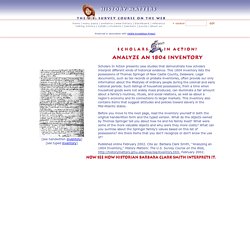
This 1804 inventory lists the possessions of Thomas Springer of New Castle County, Delaware. Legal documents, such as tax records or probate inventories, often provide our only information about the lifestyles of ordinary people during the colonial and early national periods. Such listings of household possessions, from a time when household goods were not widely mass produced, can illuminate a fair amount about a family's routines, rituals, and social relations, as well as about a region's economy and its connections to larger markets. This inventory also contains items that suggest attitudes and policies toward slavery in the Mid-Atlantic states. Before you move to the next page, read the inventory yourself in both the original handwritten form and the typed version. Inventory of Thomas Springer. Save The Pacific Northwest Tree Octopus. Help Save The ENDANGERED From EXTINCTION!
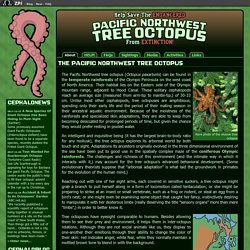
The Pacific Northwest Tree Octopus Rare photo of the elusive tree octopus The Pacific Northwest tree octopus (Octopus paxarbolis) can be found in the temperate rainforests of the Olympic Peninsula on the west coast of North America. Their habitat lies on the Eastern side of the Olympic mountain range, adjacent to Hood Canal. Mulberry Street, New York City — Viewer — World Digital Library. Historical%20Thinking%20Chart. Teacher's Guides and Analysis Tool. Map of the city of Cambridge, Middlesex County, Massachusetts. Using Maps as Primary Sources. Stacy Hoeflich: The things that I want them to see are really basic: I want them to notice all the Indian names and the detail in the waterways.

How does that apply to what John Smith is thinking and feeling? How does that apply to what the Virginia Company is thinking and feeling? How does that apply to what the Indians might be thinking and feeling? It's really simple, that I want them to notice those two things. We have done research already on the different Indian language groups and tribes. Stacy Hoeflich: What is this up here? Students: [Read item on map out loud] Stacy Hoeflich: "Significant/signification of these marks. " Students: Yeah. Stacy Hoeflich: It's telling you what these marks mean. Stacy Hoeflich: So my question is, what is this right here? Library of Congress. C3 Framework for Social Studies. The Washington times. (Washington [D.C.]) 1901-1902, July 27, 1902, Editorials The Drama And Society, Page 9, Image 25. Literacy Design Collaborative. Untitled. 2010 Profile Map United States.
Panorama of Flatiron Building / Rights assessment is your responsibility.
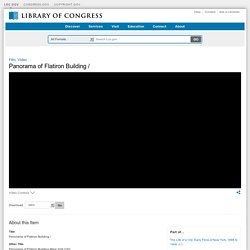
Motion Picture, Broadcasting, and Recorded Sound Division, Library of Congress The Library of Congress is providing access to these materials for educational and research purposes. The written permission of the copyright owners and/or other rights holders (such as publicity and/or privacy rights) is required for distribution, reproduction, or other use of protected items beyond that allowed by fair use or other statutory exemptions. The Library of Congress is not aware of any U.S. copyright in the motion pictures in these collections. Twentieth century transportation. Title: Twentieth century transportation / E.S.
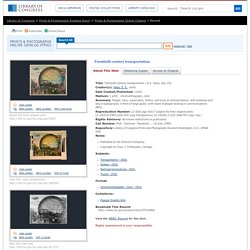
Yates, des. Chi. Creator(s): Yates, E. S., artist Date Created/Published: c1910. Medium: 1 print : chromolithograph, color. View the MARC Record for this item. Rights assessment is your responsibility. The Library of Congress generally does not own rights to material in its collections and, therefore, cannot grant or deny permission to publish or otherwise distribute the material. Rights Advisory: No known restrictions on publication. If an image is displaying, you can download it yourself. Alternatively, you can purchase copies of various types through Library of Congress Duplication Services.
If a digital image is displaying: The qualities of the digital image partially depend on whether it was made from the original or an intermediate such as a copy negative or transparency. Tampering with History Article Social Education Vol 73 No 5 Sept 2009. Elementary Learners, Fall 2010 - TPS Quarterly- Teaching with Primary Sources. This issue explores how teachers can use primary sources with elementary students.More about this issue's theme Research and Current ThinkingSummaries of and links to online resources-articles, research reports, Web sites, and white papers-that provide research and current thinking relating to the issue's theme.

Teacher SpotlightVicki Heisler, a 30-year teaching veteran in Greeley, Colorado, engages her 5th grade students with primary sources. Learning Activity – Elementary Grades K-2Students participate in a timed 30-second look at a historic photograph of a classroom, record and compare their observations and later re-examine the photograph to discuss similarities and differences between their classroom and this one from the past. Calisphere: [Advertisement for packet ship "Apollo"] Guides - Primary Source. Browse select resource guides here.
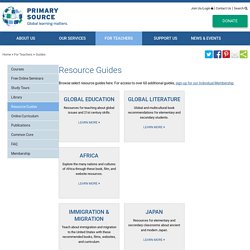
For access to over 60 additional guides, sign-up for our Individual Membership. Global Education Resources for teaching about global issues and 21st century skills. Learn More Global Literature. Library of Congress. The Norman B. Leventhal Map Center. MFA Educators Online. Historical Thinking and Close Reading In-District Survey (Cambridge)